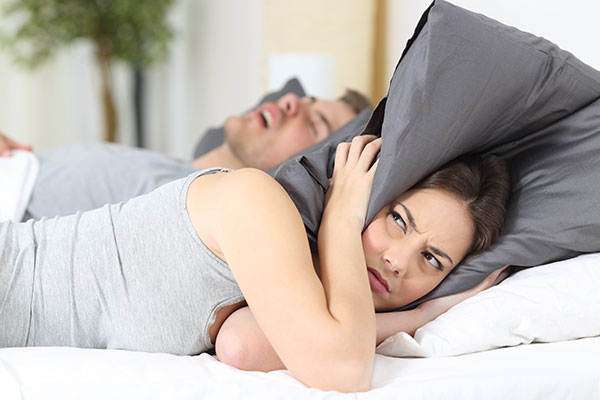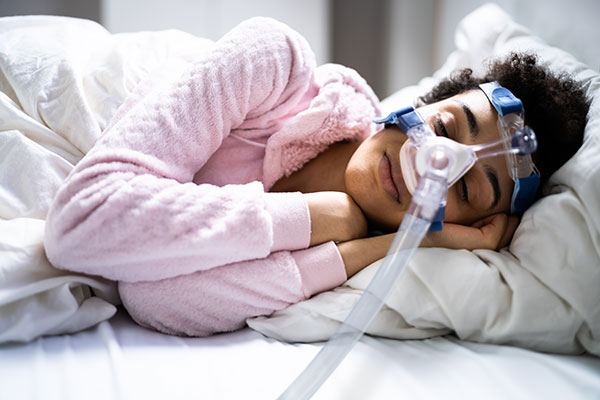Do You Have Central Sleep Apnea?
Do you wake up each morning feeling tired, irritable, and struggling to concentrate throughout the day? For those suffering from central sleep apnea, this is a daily reality. While central sleep apnea isn’t as prevalent as other sleep disorders, such as obstructive sleep apnea, it can still occur in individuals.
To learn more about treatment options, contact our dentist in Sacramento today by calling (916) 929-9222.

What Is Central Sleep Apnea?
Central sleep apnea is a sleep-related breathing disorder characterized by the brain’s inability to stimulate breathing muscles, leading to recurrent pauses in breathing. Primary central sleep apnea can be attributed to other medical conditions, such as heart failure and stroke, and sleeping at high altitudes. Less than 1% of the general population is affected by central sleep apnea, but certain risk factors like age, gender, and underlying medical conditions can increase the likelihood of developing the condition.
Central vs. Obstructive Sleep Apnea
Sleep apnea involves breathing difficulties during sleep, but it can have two different causes. Central sleep apnea occurs due to a problem with the brain, while obstructive sleep apnea is caused by physical blockages in the airway. Central sleep apnea results from the brain and the muscles responsible for respiration not functioning correctly, leading to intermittent breathing interruptions. Central sleep apnea occurs most commonly during non-rapid eye movement (NREM) sleep.
The Role of the Brain in Breathing Regulation
The brain plays a pivotal role in regulating breathing through the respiratory center located in the medulla oblongata. This center sends signals to the muscles involved in respiration to initiate and control breathing, ensuring a proper respiratory process. When there’s a disruption in this process, it can lead to central sleep apnea, as the brain is unable to send the necessary signals to the muscles responsible for respiration.
Types of Central Sleep Apnea
Cheyne-Stokes Breathing Pattern
Cheyne-Stokes breathing pattern is a type of central sleep apnea characterized by alternating periods of shallow and deep breathing, commonly seen in patients with heart failure, stroke, or renal failure. This pattern is attributed to ventilatory instability. By addressing the underlying causes, such as heart failure, it may be possible to alleviate the symptoms of this specific type of central sleep apnea.
High-Altitude Periodic Breathing
High-altitude periodic breathing occurs at high altitudes due to decreased oxygen levels. It’s characterized by alternating periods of shallow and deep breathing, with a shorter cycle length than Cheyne-Stokes breathing. This form of central sleep apnea underscores the need to take environmental factors, like altitude, into account during the diagnosis and treatment of sleep apnea.
Complex Sleep Apnea
Complex sleep apnea is a combination of both obstructive and central apneas during sleep. It can occur in individuals previously diagnosed with obstructive sleep apnea who develop central sleep apnea during continuous positive airway pressure (CPAP) treatment.
Effectively managing and improving the quality of life in complex sleep apnea cases requires addressing the unique combination of obstructive and central sleep apneas.
Diagnosing Central Sleep Apnea
Symptoms
If you’re experiencing any of the following symptoms, you may undergo a sleep study to determine if you have central sleep apnea:
- Breathing pauses
- Chronic fatigue
- Difficulty staying asleep
- Difficulty concentrating
- Morning headaches
- Shortness of breath
- Noisy breathing
- Increased urination at night
- Mood changes
Sleep Study
Sleep studies, such as polysomnography, play a vital role in diagnosing central sleep apnea. These studies monitor and record various physiological parameters during sleep, such as:
- Brain activity
- Heart rate
- Breathing patterns
- Oxygen levels
Conducting a sleep study enables healthcare professionals to diagnose central sleep apnea accurately and distinguish it from other sleep disorders.
Medical History
A thorough medical history and evaluation of symptoms can help doctors determine the presence of central sleep apnea and its underlying causes. Evaluating the patient’s medical history, symptoms, and any other relevant information is critical to ensure an accurate diagnosis and plan the treatment accordingly.
Treatment Options for Central Sleep Apnea
Continuous Positive Airway Pressure (CPAP)
CPAP is a common treatment for central sleep apnea. It involves the use of a mask that delivers continuous air pressure to keep the airway open during sleep. The CPAP machine pumps air into the airway, promoting regular respiration and preventing the recurrent pauses in breathing characteristic of central sleep apnea.
Bilevel Positive Airway Pressure (BiPAP)
BiPAP is an alternative to CPAP, providing two levels of air pressure to help regulate breathing during sleep. The higher pressure assists in maintaining the airway open during inhalation, while the lower pressure facilitates keeping the airway open during exhalation. This dual-pressure system can make BiPAP more comfortable to use than CPAP, providing more natural breathing patterns.
Supplemental Oxygen and Lifestyle Changes
Supplemental oxygen is another treatment option for central sleep apnea, involving breathing in oxygen through a mask while sleeping. This therapy can help reduce the number of apneas by supplying a constant flow of oxygen to the lungs.
Lifestyle modifications can also be beneficial in managing central sleep apnea. Weight loss and avoidance of alcohol consumption can help reduce the frequency and intensity of apneas. By incorporating these changes, individuals with central sleep apnea can experience improved sleep quality and overall health.

Risk Factors and Complications
Risk Factors
Risk factors for central sleep apnea include:
- Age
- Gender (more common in males)
- Presence of other medical conditions such as heart failure or stroke
- Obesity
- Smoking
- Alcohol consumption
- Certain medications
Complications
Complications of untreated central sleep apnea can lead to:
- Daytime drowsiness
- Irritability
- Difficulty concentrating
- Increased risk of cardiovascular issues
- Stroke
- Mood disorders
- Worsening of existing health conditions
Frequently Asked Questions
What are the symptoms of central sleep apnea?
There are various symptoms individuals may experience with central sleep apnea, including:
- Loud snoring
- Gasping for air during sleep
- Pauses in breathing
- Morning headaches
- Difficulty staying asleep
What is the most common cause of central sleep apnea?
The most common cause of central sleep apnea is related to obstructive sleep apnea or an underlying medical condition. In rare cases, it may be caused by recent ascent to high altitude or narcotic use.
Get the Sleep Apnea Treatment You Need
With the right knowledge and support, individuals affected by central sleep apnea can take control of their condition and improve their sleep, health, and overall quality of life. Don’t let central sleep apnea hold you back — contact our Sacramento dental office today by calling (916) 929-9222 to schedule your appointment.
